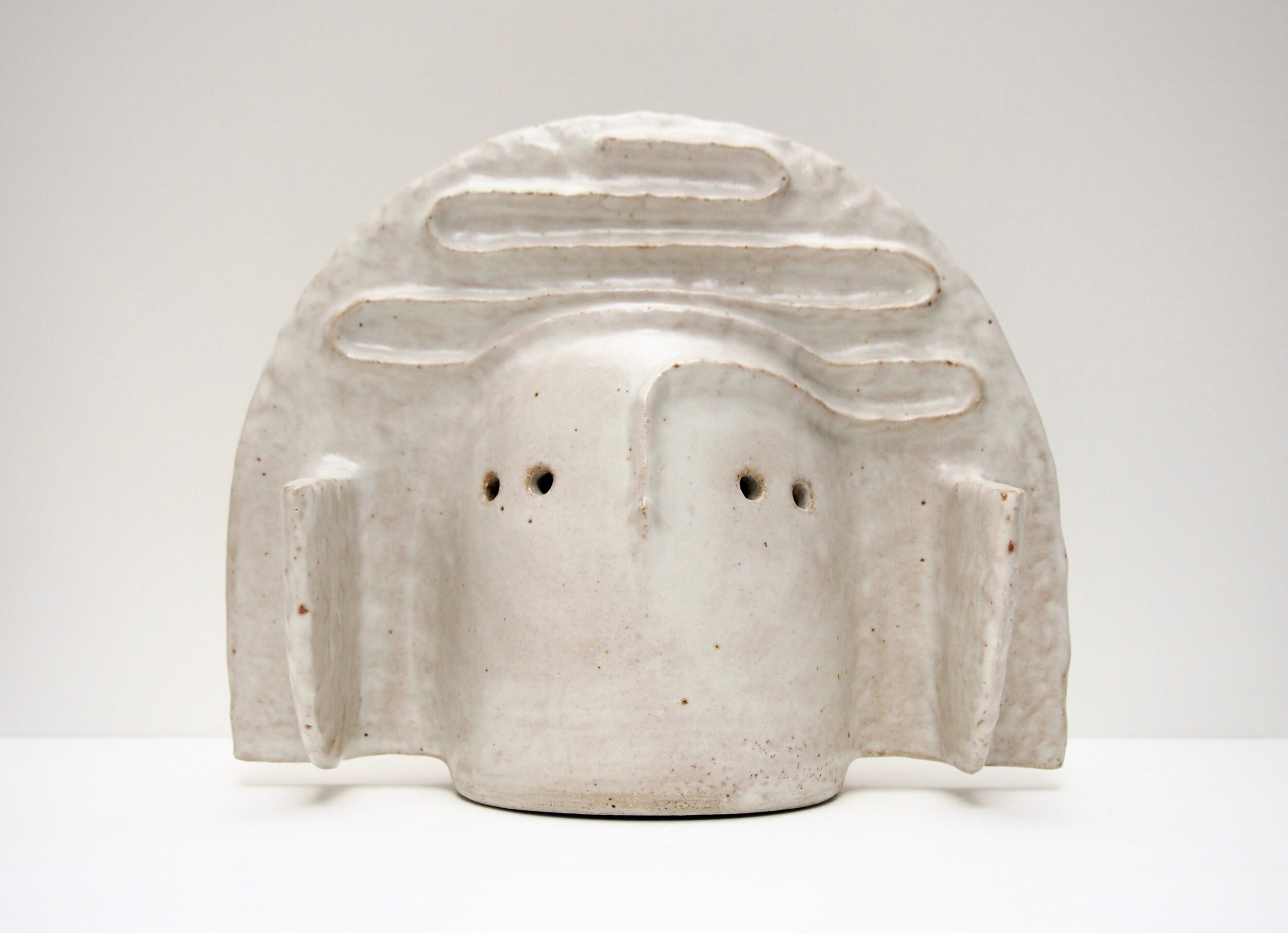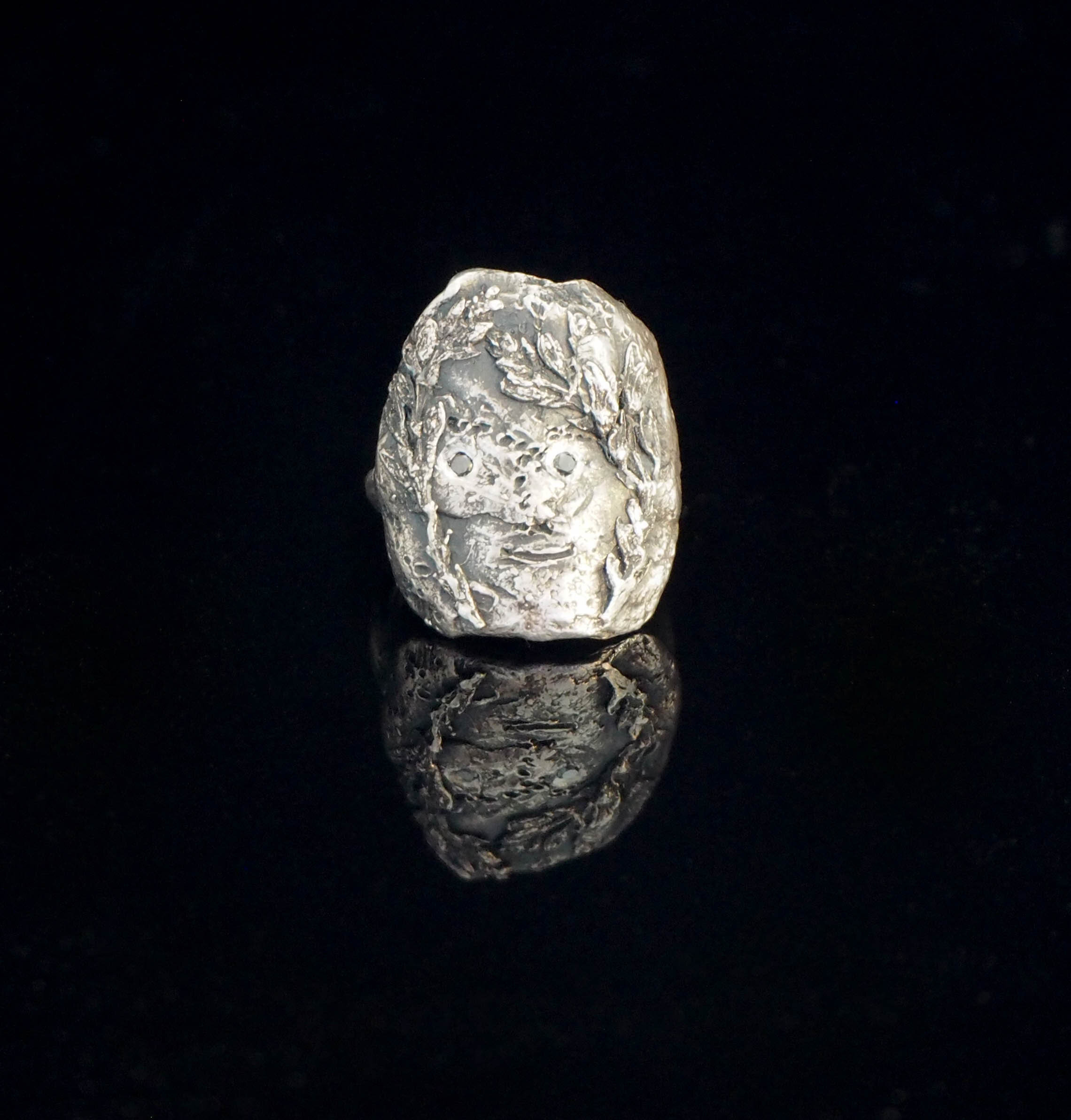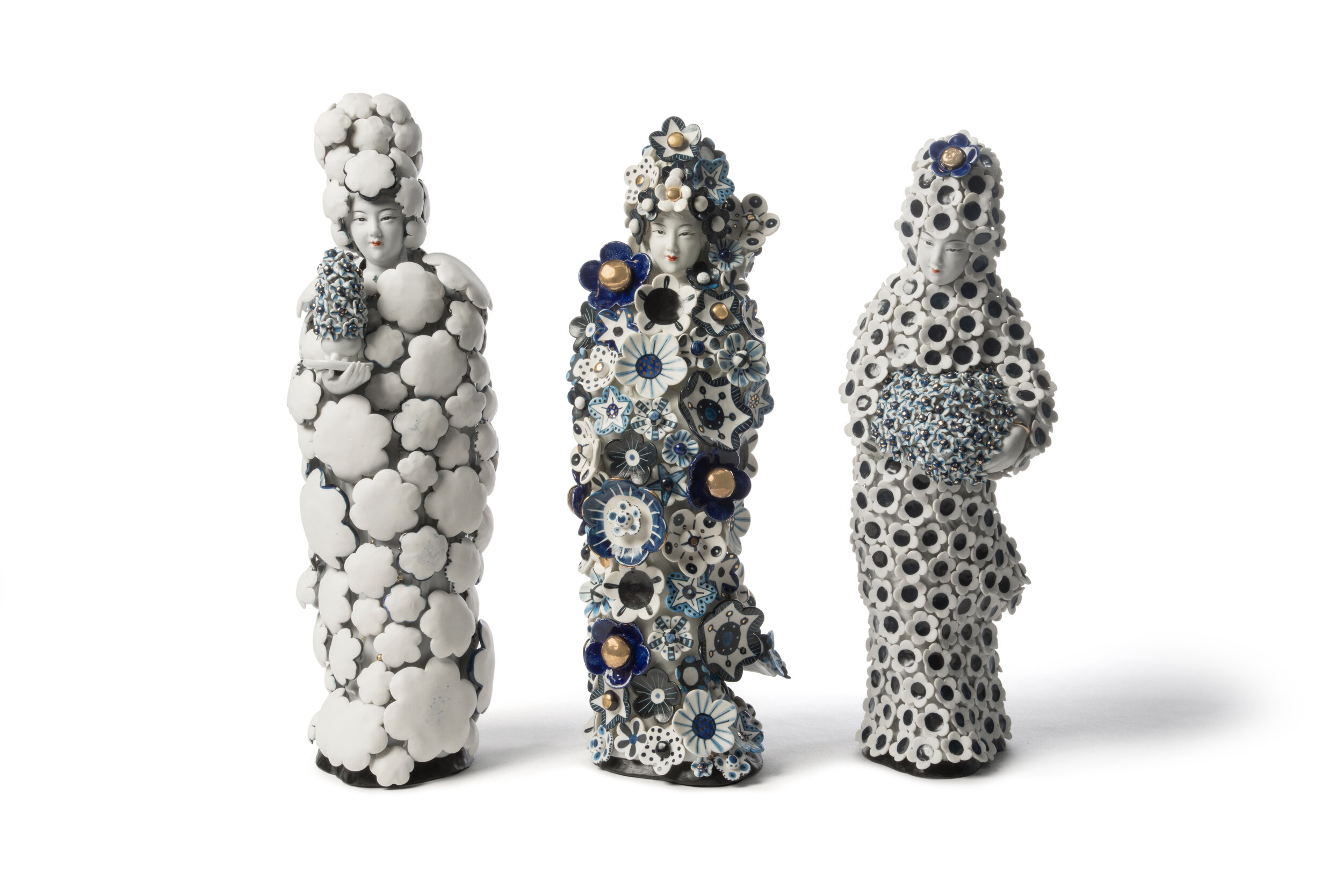Exhibition Insight... Modern Mysticism
Peta Armstrong, Hoodoo, 2020, stoneware, 285 x 250 mm. Photo: The artist.
Modern Mysticism
Words by Caitlin Eyre
Throughout the ages, artists have been bestowed with the task of crafting of sacred objects to support and fulfil the religious and spiritual beliefs of their culture and society. Such objects include sculptures that represent or embody sacred beings, tools used for worship or ceremonial purposes, and talismanic items believed to possess the power to heal ailments, offer protection, bring good fortune or invoke higher powers. The power of sacred images, symbols and objects continues to hold great importance in contemporary society, with the rich imagery and materiality continuing to inspire artists in the creation of new pieces of art, craft and design. Modern Mysticism invites the viewer to consider our connection with sacred objects, and the experience of the maker in creating material objects that are imbued with divine reverence and otherworldly powers.
Peta Armstrong, Mojo, 2020, stoneware, 215 x 260 mm. Photo: Peta Armstrong.
Echoing beliefs surrounding the healing properties of sacred objects, ceramic artist Peta Armstrong utilises her practice to explore masks and the different roles they play in disguise, protection and performance. In the creation of her sculptures, Armstrong was influenced by both the faces she saw emerge spontaneously from the clay and those that came to her in her dreams. While the ceramic masks undoubtedly invoke the ceremonial use of such objects in sacred rituals, for Armstrong the act of making is also imbued with great significance and power. “It is my own malaise that is being relieved with the making,” Armstrong says. “There is relief and meditation in the process of making that allows me to imagine it is an actual ceremony in itself.” However, Armstrong is also interested in how the positive intentions she has while making her sculptures can be transferred to the observer of her artwork. The ambiguity at play in these sculptures allows the viewer to create their own personal narratives within the artworks to facilitate meaning, healing and ritual, making them an important tool in personal analysis. In this way, Armstrong’s masks are modern day idols imbued with the power to remedy the general malaise and negativity that arise in daily life. “If I can allow my mind to wander and be in a peaceful state when making, can the observer not do the same?” muses Armstrong. “It is the relief I want to share, first with the eyes and then with the intention of the observer.” In contemplating the role of the maker in crafting sacred objects, Armstrong’s experience of making poignantly underscores the sacredness of the process as well as the significance of the finished object.
Juan Castro, Clotos Ring, 2018, 9ct yellow gold set with emerald cut amethysts, 22 x 22 x 21 mm on 5mm wide band. Photo: The artist.
Juan Castro, Bizancio Earrings, 2017, Oxidised sterling silver, 9ct yellow gold, akoya pearls, 80 x 25 x 24mm. Photo: The artist.
Spanish-born jeweller Juan Castro creates opulent jewellery that is influenced by a juxtaposition of religious adornments and iconography, ancient Mediterranean cultures, Byzantine jewellery, archaeology and mythology. Profoundly attracted to adornment since he was a child, Castro has based his jewellery practice on his desire to evoke beauty by reimagining historical adornment in a distinctly contemporary context. His jewellery collections feature the sumptuous materiality of gold, pearls and precious gemstones, and often incorporate abstracted symbols drawn from Catholic religious iconography, including radiant gold halos, double barred crucifixes, stylised tears and the Caravaca crucifix, a traditional Catholic amulet of protection dating to 14th century Spain. The eclectic collection featured in Modern Mysticism reflects the diverse aesthetics of the different cultures that have contributed to the history of Spain and which have so greatly influenced Castro’s jewellery practice. “From the colours of elaborate Moroccan tiles….to votive religious crowns from the Visigothic Spanish civilisation,” Castro muses. “All of these pieces carry with a juxtaposition of everything that has inspired me since childhood”.[i]. The collection includes intricate gold laurel-leaf shaped earrings, grand chandelier-style earrings crafted from oxidised sterling silver and adorned with gold and pearls, and lavish multi-faceted gold rings set with emerald-cut amethysts and green tourmaline. While often drawn to the stories of Greek mythology, such as those which have inspired the creation of the Midas and Atropos rings, Castro’s jewellery nonetheless honour the myriad of historical and cultural influences that inform his distinctly layered aesthetic. The rings incorporate a palette of colours from the Arabic influences in each corner of southern Spain and feature regal square cut gemstones that reference the shapes of Visigothic jewels and objects.[ii] Multi-faceted and complex, Castro’s jewellery suggests the diverse origins of the symbols and motifs that comprise the rich material culture and traditions of Western religious adornment.
Emma Homfray, Elemental Presence Ring, 2020 oxidised silver, black diamonds, 23 x 20 x 21 mm. Photo: The artist.
Emma Homfray, Mother Snake, Dark Moon Ring, 2018, oxidised silver, pearl, 25 x 30 x 20 mm. Photo: The artist.
Multidisciplinary artist and jeweller Emma Homfray uses her creative practice to engage in the imagery of myths, ancient mysteries and the occult. Intensely personal, Homfray’s artworks are crafted as an almost sacred ritual that allows her to connect with the inner world of dreams, emotions and encounters with ‘the other side’. In this exhibition, Homfray has crafted a selection of talismanic jewellery that draws on her own experiences with the occult. “These objects help to traverse the spirit world,” says Homfray. “Or to see the spirit world in living and breathing harmony with this one.” Connecting with the belief in the inherent talismanic qualities of symbols, motifs and materials, Homfray’s jewellery explores the way in which sacred objects can assist us in accessing spiritual planes for the purpose of self-discovery. The Pearl Crowned Serpent Ring, for example, features a coiled black snake adorned with a single black pearl, the oxidised silver and dark-toned pearl chosen to represent the dark moon and the energies of Binah, Hekate and the high priestess of the Tarot. Signifying the journey to the underworld, this ring encourages the wearer to engage their subconscious mind and enter a state where they can access the important messages that are placed for us in the world of dreams. In keeping with the time-honoured tradition in Western occultism of making one’s own magic objects and sewing pouches for their safekeeping, the jewellery in this collection is presented along with individually hand-painted and embroidered cloths. The pieces are intended to be wrapped in the embellished cloths when they are not being worn in order to preserve their energetic charge and to ensure they are used in their most powerful state. In this way, Homfray’s jewellery pieces simultaneously serve as both objects of symbolic beauty and practical tools to assist in accessing the sacred, contemplative space within our own consciousness.
Vikki Kassioras, Algea, 2020, sterling silver, 65 mm (length). Photo: The artist.
Vikki Kassioras, Pirene, 2020, sterling silver, 130 mm (length). Photo: The artist.
Greatly inspired by the rituals and beliefs of the ancient world, Vikki Kassioras is a gold and silversmith who is fascinated by classical mythology and its ability to shed light on the human condition. Her practice is influenced by a lifelong interest in archaeology, mythology and the aesthetics of ancient Greek and Etruscan jewellery. An ardent storyteller, Kassioras often looks to ancient myths and legends to inspire her in the creation of thematic jewellery that is relatable to the wearer despite the apparent barrier of time and place. By linking past and present through the use of archetypal symbols and stories, Kassioras assists us in understanding our place in the world and the shared experience of the human condition through the ages.[iii] For her most recent body of work, the Tear Charmers collection, Kassioras has focused her research on ritual tears and stories from classical mythology that have themes relating to grief, sorrow and distress. In this collection, Kassioras uses stylised eye and tear shapes to symbolise these stories and the human experience of these deep emotions. As a result of her interest in archaeology and the ancient world, Kassioras utilises an array of ancient gold and silversmithing techniques in her contemporary jewellery practice, including fusing and reticulation. The process of reticulation is particularly significant in Kassioras’ practice and involves heating a sheet of gold or silver alloy up to ten times in order to oxidise the copper at the surface and then pickling it remove the oxide, resulting in a thin layer of pure metal. The metal is then heated to produce the heavily wrinkled, ridged and textured surfaces that give many of Kassioras’ contemporary jewellery pieces the appearance of a recently uncovered ancient artefact.[iv] “It is a minimal way of working,” says Kassioras, “yet it allows me great scope for producing individual contemporary works that flirt with antiquity.”
Tara Lofhelm, The Offering Earrings, 2020, sterling silver with oxidisation and fused gold leaf, lacquer, 120 x 30 x 1 mm. Photo: The artist.
Tara Lofhelm, Divination Earrings, 2020, oxidised sterling silver, 18ct yellow gold, 90 x 50 mm. Photo: The artist.
Intrigued by the devotional practices of ancient civilisations, jeweller Tara Lofhelm finds solid grounding within the long tradition of talismanic adornments worn for guardianship and protection against evil forces. “Traversing time, place and metaphysical space, my jewellery seeks to question the essence of our modern day existence,” says Lofhelm. Created through the eyes of a curious non-believer, Lofhelm’s jewellery draws inspiration from the rich imagery of mysticism, Pagan belief systems, cosmology and tribal scarification. In her practice, Lofhelm explores textural repetition and contrast through primitive processes such as twisting, stamping and embellishment to produce bold pieces that highlight and celebrate the hand of the maker.[v] Presented as the reimagined fragments of recently uncovered ancient relics, Lofhelm’s most recent collection reflects on humanity’s eternal search for meaning and guidance, as well as exploring jewellery’s ability to empower and embolden the wearer through otherworldly means. “As humans have always sought guidance from external forces, these designs send a Divine revelation that power is hidden within ourselves if we stop and observe long enough to discover it,” Lofhelm says. Inspired by ancient communication through symbols such as cuneiform and hieroglyphics, Lofhelm’s Divination Earrings have the appearance of broken segments of an ancient frieze that although removed from its place of worship, continue to offer us clues to the wisdom of an ancient belief system. Many of Lofhelm’s pieces incorporate archetypal symbols and script, both real and invented, in order to explore and pay homage to the diverse spiritual influences found within her collection. Imagined as a holy ceremonial offering that would adorn a high priestess, Lofhelm’s Scripture Earrings are inscribed with invented scripture, devotional symbols and abstracted depictions of holy leaders and their worshippers. The simplified stick figure motifs are reoccurring symbols throughout Lofhelm’s practice and echo the archetypal human experience of spirituality throughout the history of civilisation.
Vipoo Srivilasa, When I discover who I am, I’ll be free (series), 2019, Chinese figurine, porcelain, blu tack, dimensions variable. Photo: Andrew Barcham, courtesy of Scott Livesey Galleries, Melbourne, Edwina Corlette Gallery, Brisbane and Olen Gallery, Sydney
Working predominantly in ceramics, Vipoo Srivilasa is a Thai-born Australian artist who creates contemporary porcelain sculptures that reference his own migrant story and transmit a universal message about cross-cultural experiences.[vi] Seamlessly blending elements of East and West, Srivilasa’s hand-built sculptures are imbued with a playful juxtaposition of historical figurative and decorative art processes with recognisable elements from contemporary culture. Drawing on the traditions of fine Asian porcelain, Srivilasa usually works with a restricted colour palette of cobalt blue, white and gold that, although bearing a distinctly Asian aesthetic, also references the exportation of porcelain from China to Europe hundreds of years ago.[vii] The common thread of porcelain across East and West poignantly underscores the inherently ingrained cross-cultural exchanges that have long been present in seemingly different and separate cultures. Often appearing as opulent contemporary idols enshrined in porcelain flowers, Srivilasa’s figurative sculptures are an ever-present nod to the artist’s Thai Buddhist heritage. Countering his usual time-consuming hand-building processes, in When I Discover Who I Am, I’ll Be Free Srivilasa has chosen to instead modify factory-made porcelain sculptures imported from China. The series features three traditionally dressed Chinese women that Srivilasa has adorned with porcelain flowers that have been handmade and hand-painted in Australia. The flowers have been adhered with Blu-Tack, an unusual choice of adhesive that when paired with the figures serves as a metaphor for the delicate connections that are made two cultures unite as one. Fixed deliberately in place and yet vulnerable to unpredictable knocks, the flowers offer a poignant reminder of the need for constant vigilance in protecting the promise of harmonious cultural diversity. “Two different cultures can come together as one, but it is a fragile and delicate matter,” says Srivilasa. “We do need to treat it with respect, care and understanding.” In this way, Srivilasa’s altered, mass-produced Chinese icons become a powerful message of cultural tolerance and understanding in contemporary Australian society.
By presenting diverse approaches to making objects influenced and inspired by spiritual, religious and esoteric sources, Modern Mysticism explores the shared human experience of the sacred across time, place and culture, while also underscoring the significant role that artists and material objects play in supporting spiritual beliefs and practices in a contemporary context.
All unattributed quotes in this essay are from interviews with the artist.
Modern Mysticism is showcased in Gallery Two at JamFactory Adelaide from 18 May - 20 September. Open to the public from 6 July 2020.
i Juan Castro, ‘Augurio’, https://www.piecesofeight.com.au/collections/augurio, accessed 20 April 2020
ii Juan Castro, ‘Midas Ring’, https://www.piecesofeight.com.au/products/midas-ring, accessed 29 April 2020
iii Vikki Kassioras, ‘Vikki Kassioras’, https://egetal.com.au/artists/vikki-kassioras/, accessed 16 April 2020
iv Vikki Kassioras, ‘Vikki Kassioras’, https://egetal.com.au/artists/vikki-kassioras/, accessed 16 April 2020
v Tara Lofhelm, ‘Modern Mythologies’, http://taralofhelm.com/collections/modern-mythologies/, accessed 20 April 2020
vi Vipoo Srivilasa, ‘Bio’, https://vipoo.com/bio, accessed 10 April 2020
vii Caitlyn Gregson, ‘The Dreamline Figurines of Vipoo Srivilasa’, https://beautifulbizarre.net/2019/02/04/the-dreamlike-figurines-of-vipoo-srivilasa/, accessed 21 April 2020











